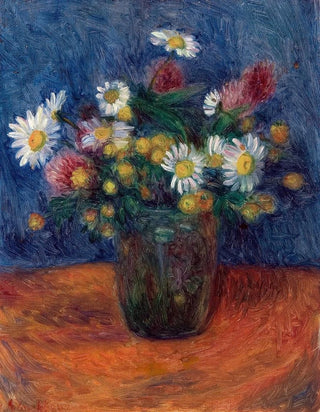Art print | Flowers - William James Glackens


View from behind

Frame (optional)
In the world of art, some works transcend their era to become timeless witnesses to human beauty and creativity. "Fleurs - William James Glackens" is one of these pieces, where nature and artistic sensitivity meet in a dazzling harmony. This painting, with its vibrant colors and delicate expression, invites the viewer to immerse themselves in a floral universe where each petal seems to vibrate with its own life. Glackens' work is not limited to a simple depiction of flowers; it evokes an atmosphere, an emotion, a deep connection with nature that still resonates today.
Style and uniqueness of the work
William James Glackens' style is often associated with American Impressionism, but "Fleurs" stands out with an approach that is uniquely his own. Glackens' technique, characterized by bold brushstrokes and a rich palette, creates a captivating visual dynamism. The flowers, rendered with delicate precision, almost feel tangible, as if you could smell their fragrance while contemplating them. Light plays a fundamental role in this piece, illuminating the colors and emphasizing the forms, giving each element a unique presence. Glackens manages to capture the very essence of nature, transforming the mundane into the sublime. This ability to breathe life into his subjects is what makes "Fleurs" so memorable and timeless.
The artist and his influence
William James Glackens, an emblematic figure of early 20th-century American art, knew how to leave his mark with his bold vision and innovative approach. A member of the "Ashcan School," he sought to depict everyday life and urban landscapes with a sensitivity that is uniquely his own. His influence extends far beyond his time, inspiring many artists who followed in his footsteps. Glackens also played a crucial role in promoting modern art in America, paving the way for a broader appreciation of contemporary artistic movements. His ability to incorporate elements of popular culture and social themes into his work helped evolve perceptions of art, making him a pioneer in the field. "F

Matte finish

View from behind

Frame (optional)
In the world of art, some works transcend their era to become timeless witnesses to human beauty and creativity. "Fleurs - William James Glackens" is one of these pieces, where nature and artistic sensitivity meet in a dazzling harmony. This painting, with its vibrant colors and delicate expression, invites the viewer to immerse themselves in a floral universe where each petal seems to vibrate with its own life. Glackens' work is not limited to a simple depiction of flowers; it evokes an atmosphere, an emotion, a deep connection with nature that still resonates today.
Style and uniqueness of the work
William James Glackens' style is often associated with American Impressionism, but "Fleurs" stands out with an approach that is uniquely his own. Glackens' technique, characterized by bold brushstrokes and a rich palette, creates a captivating visual dynamism. The flowers, rendered with delicate precision, almost feel tangible, as if you could smell their fragrance while contemplating them. Light plays a fundamental role in this piece, illuminating the colors and emphasizing the forms, giving each element a unique presence. Glackens manages to capture the very essence of nature, transforming the mundane into the sublime. This ability to breathe life into his subjects is what makes "Fleurs" so memorable and timeless.
The artist and his influence
William James Glackens, an emblematic figure of early 20th-century American art, knew how to leave his mark with his bold vision and innovative approach. A member of the "Ashcan School," he sought to depict everyday life and urban landscapes with a sensitivity that is uniquely his own. His influence extends far beyond his time, inspiring many artists who followed in his footsteps. Glackens also played a crucial role in promoting modern art in America, paving the way for a broader appreciation of contemporary artistic movements. His ability to incorporate elements of popular culture and social themes into his work helped evolve perceptions of art, making him a pioneer in the field. "F






